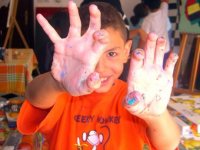How to Build Students’ Creative Confidence
I recently visited a school district where teachers are experimenting with Genius Hour. Sometimes called 20 percent time after the Google practice of reserving a day a week for individual research, Genius Hour offers students a regular time each week to tackle projects that reflect their personal interests and passions. (Blogger A.J. Juliani explains the reasoning behind 20 percent time.)
When I stopped by an elementary class during Genius Hour, I found students with no shortage of project ideas -- from rocketry to the history of ceramics. Their main challenge was finding enough time in the coming weeks to get to all the wonderful questions they were eager to explore.
It was a different story in middle school. A seventh-grade teacher confided that many students seemed stuck when she invited them to come up with research ideas. Instead of trusting their own curiosity, some went right to Google and searched for "project ideas for Genius Hour."
If we hope to inspire a generation of innovators, we can't have students second-guessing their own ability to ask good questions. As Einstein cautioned, "The important thing is not to stop questioning. Curiosity has its own reason for existing." Curiosity and creativity are closely linked, and both are essential for generating innovative solutions. Similarly, both can be hampered by a lack of confidence or fear of failure.
The Case for Creative Confidence
Creativity gurus (and brothers) David Kelley and Tom Kelley are on a mission to protect and promote what they call "creative confidence." In their new book, Creative Confidence: Unleashing the Creative Potential Within Us All, they argue that everyone has the capacity to be creative. What distinguishes the innovators from the rest of us, they add, is "believing in your ability to create change in the world around you."
The Kelley brothers make their case with stories galore, from Einstein's lab to today's social innovators working to improve living conditions in the developing world. David Kelley is the founder of both IDEO, the global design firm, and the Stanford d.school, a hotbed of design thinking. Tom Kelley, a partner at IDEO, is the author of The Art of Innovation.
Sounding a bit like personal trainers, they suggest that creative confidence "is like a muscle -- it can be strengthened and nurtured through effort and experience." They also warn of the lasting damage of "creativity scars...At the right age, a single cutting remark is sometimes enough to bring our creative pursuits to a standstill."
Ideas to Borrow
What can you do in the classroom to revive your students' curiosity and build their creative confidence? The Kelleys offer a wealth of practical suggestion, such as:
- Teach students how to represent their ideas with simple sketches
- Encourage "why?" questions
- Put up a community chalkboard where anyone can post questions, make observations, or invite others to add to a rough idea
- Expect failure as part of the learning process
- Encourage daydreaming and "thought walks"
But that's not all. OpenIDEO is an online forum for creative collaboration and problem solving. A recent prompt invited solutions to this design challenge: How might we inspire young people to cultivate their creative confidence?
More than 600 ideas were submitted from around the globe, setting a new record for OpenIDEO participation. Community feedback and prototyping sparked project improvements. In December, nine winning ideas were announced. They include the "Electronster," a traveling truck that collects used electronics so that kids can take them apart and remix the components; a creative confidence toolkit; and Thinker Teams, a cross between debate clubs and maker spaces.
Best of all, these ideas are all open source. That means anyone is free to borrow, adapt, or build upon any of the 600 submissions.
Which wild ideas fire up your curiosity or, better yet, get a thumbs-up from your students? Which ones might be worth tackling in your own version of Genius Hour? Please share your reactions in the comments.
